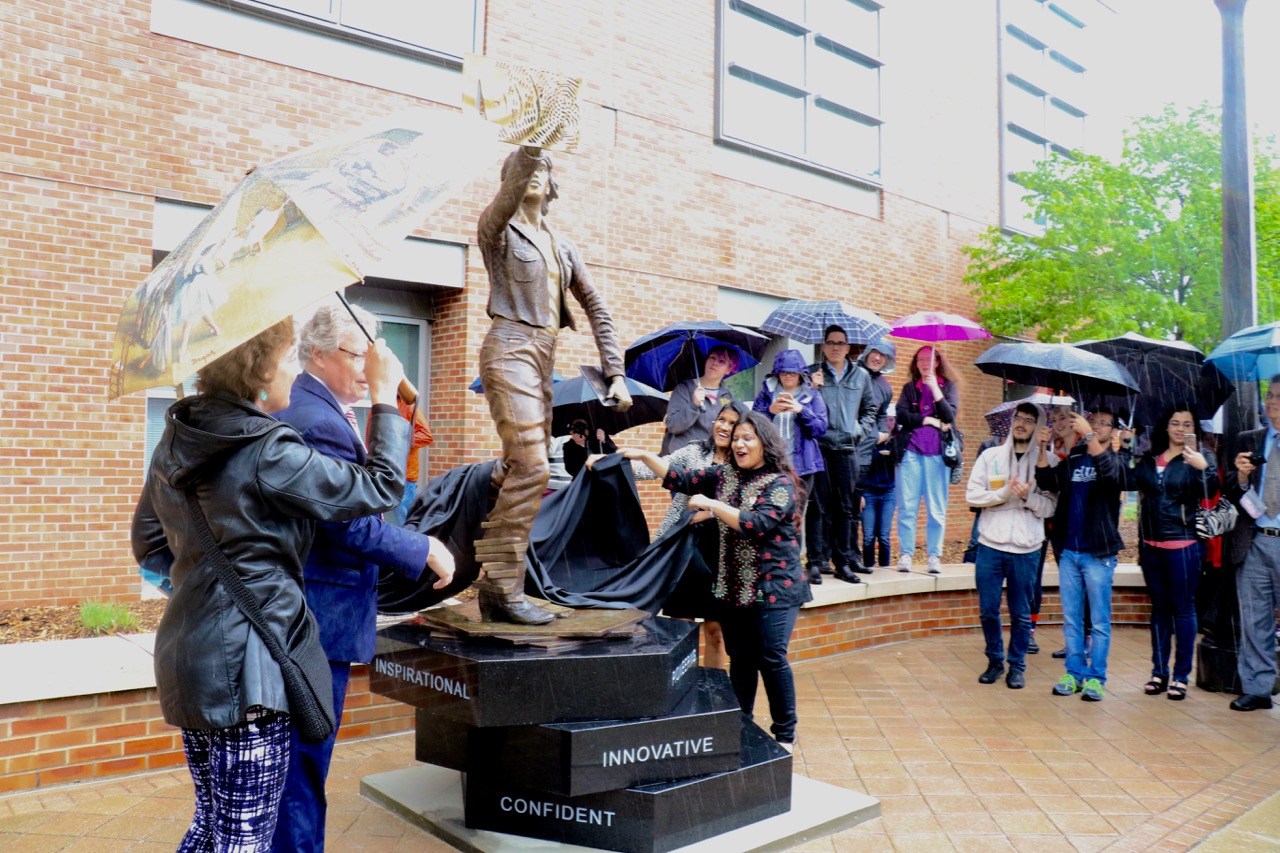What it’s like to be a woman in engineering
A statue honoring women in engineering titled “The Quintessential Engineer” is unveiled on the Engineering Quad on April 28.
Nov 30, 2017
Alyssa Licudine, freshman in Engineering, said that it didn’t take long for her to recognize the trials that women in engineering find themselves facing.
Licudine said that she faces “the critical eye of the opposite sex, the assumption that I am where I am to help fulfill a ‘diversity requirement,’ the ever-growing doubt that maybe I’m not cut out to be in this ‘boy’s’ world, let alone be a leader in it.”
However, Licudine looks forward to the day she can eventually look back and know that she succeeded, despite the adversity she faced.
“As for the doubters other than myself, I just remember it’s really all up to me to decide who or what I’m affected by. If they think I can’t do something, it gives me another reason to not only do it but also surpass their expectations,” Licudine said.
According to the University’s Division of Management Information, out of the 11,530 undergraduate, graduate and professional engineering students on campus, only 2,524 are female, which is only 21.89 percent.
Get The Daily Illini in your inbox!
A reporter from the Massachusetts Institute of Technology (MIT) wrote a column called, “Why do women leave engineering?” In his column he stated, “Overall, about 20 percent of undergraduate engineering degrees are awarded to women, but only 13 percent of the engineering workforce is female. Numerous explanations have been offered for this discrepancy, including a lack of mentorship for women in the field; a variety of factors that produce less confidence for female engineers; and the demands for women of maintaining a balance between work and family life.”
So how do women at the University feel about such a big difference in gender percentage within the workforce? It is important to consider what occurs between the time women start pursuing a degree in engineering and the moment they begin to seek their first career.
Licudine said that seeing mainly men leading the engineering industry from a young age has made it difficult for her to look past the stereotypes.
“I’d think of history’s top engineers and CEOs, of how almost all of them are men,” she observed. “I’d get stuck in believing that maybe women inherently lack a skill or ability that successful men have.”
Licudine admits that her biggest doubter is herself. She wishes that women in the engineering workforce could know they earned their spot there without the question of whether or not they were just another factor in lessening the female minority.
“I’ve been lucky to never have been sidelined because of my gender, but there’s always the expectation that I eventually will be. Despite having already come a long way in gender equality, it seems there will always remain the ingrained societal differences between us,” she said.
Currently, there are two organizations on campus that provide support for women in engineering: the Society of Women in Engineering (SWE) and the organization that welcomes all freshman female students in engineering to campus, which is Women in Engineering (WIE).
Katy Walters, the Professional Liaison Director of SWE, joined the organization as a freshman after immediately noticing the strong network that the organization could provide for her.
“I have been able to develop my soft skills, including public speak and leadership on top of the technical skills I have acquired from my classes. I have gained mentors and served as a mentor to new and incoming students,” Katy said. “I knew that being involved would allow me to better myself.”
SWE works extensively with science, technology, engineering, and mathematics (STEM) to provide its members with an experience greater than just their specific course curriculums. The society strives to prepare members for STEM research so that they can eventually contribute to the female minority within the workforce.
Katy views the organization as a long-term commitment, and feels that it does more than just prepare women for the future.
“SWE is a nationwide (and increasingly global) organization so my involvement does not have to end when I graduate and my network can always be expanding,” she said.
In May, the female engineering community on campus officially completed their four-year campaign for a statue named “The Quintessential Engineer.” The statue is a woman, created to reflect all young women, and now stands outside of the Micro and Nano-Technology Laboratory.
“The face, the expression is one of wonder, exploration, and knowledge, one of curiosity and perseverance. She represents a multi-racial female, a young professional woman at work… Always thinking, on the move,” Julie Rotblatt-Amrany, the artist, explained.
Both SWE and WIE dedicate their respective work to raising the percentage of women in the engineering workforce and weakening the ingrained gender inequality within the engineering field on and off campus in order to allow women to make a difference on a larger-scale.






